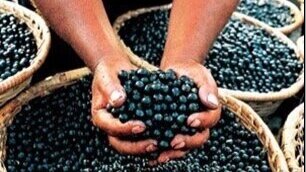TRADITIONAL FOODWAYS
Strengthening endangered traditional food systems
and conserving biological and cultural diversity
Overview video - English
Video introductorio - Español
Food is found at the intersection of culture and nature. It grows from the accumulated wisdom of generations, a blend of inherited knowledge and the innovations of individual farmers, hunters, gatherers and cooks. People have long exchanged this wisdom, and associated plants and animals, across cultures and large geographic areas, but food traditions are also tied to place, they are inherently “local”.
This is particularly true for the many traditional foods that are wild harvested, or semi-domesticated, as well as livestock and agricultural varieties that depend upon distinct soil, climate, and growing traditions. In many areas, entire landscapes are managed to produce food, with home gardens, farms, grazing lands, fallow, and forest contributing in distinctive and complementary ways across seasons.
Eposi Sophie cooking kwakoko bible. Limbe, Cameroon. (Photo: Annette Dingha)
Cultural practices and biological diversity are inextricably linked, and the continuation of unique and sophisticated knowledge systems associated with wild-harvesting, managing, cultivating, and preparing foods depends upon the conservation of biodiversity and cultural landscapes.
But traditional knowledge and biological diversity are under threat, often for the same reasons: industrial agriculture and associated land grabs, logging, mining, oil exploration and the broader economic and cultural pressures of globalization. People have long adapted their food systems to changing circumstances and experiences, incorporating new foods and practices and dropping others along the way. However, external pressure on forests and biodiversity, and traditional knowledge and practices, has never been greater.
Fish wrapped using clay, before grilling. West Kalimantan, Indonesia. (Photo: Wahyu Widhi)
The Traditional Foodways Program supports traditional food systems in their entirety – the sustainable harvesting, management, cultivation, processing, and preparation of a wide range and astonishing number of food species. Rather than specific foods, however, it is these complex and diverse food systems that are most endangered today, dependent as they are on threatened traditions and biologically diverse environments.
“An apparently simple object, food in fact distills a range of complex social and ecological relations.”
RECIPES FROM THE INTERWEAVE OF PEOPLE AND PLACE
In 2022, People and Plants International produced a recipe video series that documents and celebrates delicious and healthy traditional cuisines interwoven with the forests and environments from which they grow. The series provides a glimpse into the layers of knowledge that go into a recipe – the wisdom of generations and innovations of individual cooks, farmers, hunters, and gatherers. We also explore the traditional management systems that produce these nutritious, diverse, and seasonal foods and ingredients, as well as the threats to these environments and cultural practices.
We invite you to watch the overview video presenting the series, and the collection of recipe videos featuring dishes from The Philippines, Ecuador, Cameroon, Mexico and Indonesia. Learn more.
Our work
Amazonian boy enjoying bacuri (Platonia insignis)
Many rural communities would like to slow the pace of change and shore up and celebrate what they know and have in order to maintain healthy, secure and diverse diets. The Traditional Foodways Program is an effort to help them do this. It celebrates extraordinary cultures and environments, and strengthens communities by bringing them together around the universal interest in food. It seeks to bolster and revive traditional food systems while they are still relatively intact, and are embedded in the environments and cultures from which they arose, and revive and restore those that have been degraded. Our work includes:
Sustainable harvesting and management strategies to restore underutilized, rare or threatened food species
Manuals and other materials documenting the management, harvesting and processing of wild, semi-domesticated, and cultivated food species, and food preparation
Recipe-exchanges and locally-produced cookbooks, and a series of recipe videos
Cultural revival festivals in towns to celebrate traditional food systems; these include showcasing home gardens, food preparation demonstrations and cooking contests, village-based theatre, and traditional dance and music associated with harvest seasons and particular foods
The cooking contest at the Traditional Food Festival, West Kalimantan, Indonesia. (Photo: Wahyu Widhi)
School materials, including traditional food packets, posters, and games, and associated teacher training programs
Interactive programs in local schools, including stories from elders, traditional food harvesting and preparation, lessons on the links between medicine and food, and historical uses of foods by ancestors
Exchanges across regions, in which communities meet and share experiences and lessons learned
Traditional food videos, produced in partnership with community members and local organizations, and training collaborators in design, filming and editing
Global awareness-raising about the need to support and conserve biological and cultural diversity as integral parts of diverse and healthy food systems by producing articles, videos, and education materials for international audiences.
Policy materials to promote laws that support traditional foodways, including support for land and resource rights, customary law, and traditional management practices.
The Milpa system: contribution from Mesoamérica to the world
Xavier Martínez Esponda - CEMDA, AC. Xalapa, Veracruz, Mexico.
Sambit Immaculate harvesting corn in her farm in Ngeme, Cameroon. (Photo: Annette Dingha)
The importance of Milpa in the Nahua region of the Sierra de Zongolica.
Fortunata Panzo Panzo. Duraznotla, Veracruz, Mexico.
Bacuri (Platonia insignis), a delicious Amazonian forest fruit. (Photo: Patricia Shanley)
Pounding fruits, ‘milling’ palm oil, from the native Elaeis guineensis, Cameroon. (Photo: S.A. Laird)
Sambit Carine making palm oil, Limbe Cameroon. (Photo: S.A. Laird)
Cesilia Xillohuo grinding corn to make tortillas. Tequila, Veracruz, México. (Photo: Gabriela Alvarez)
Lena Wildschut and Siena van der Ross preparing traditional gharra beer, South Africa. (Photo: Vuyiswa Lupuwana)





















